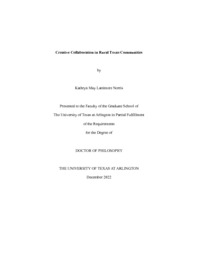
ATTENTION: The works hosted here are being migrated to a new repository that will consolidate resources, improve discoverability, and better show UTA's research impact on the global community. We will update authors as the migration progresses. Please see MavMatrix for more information.
Show simple item record
| dc.contributor.advisor | Rodriguez, Alejandro | |
| dc.contributor.advisor | Bezboruah, Karabi | |
| dc.contributor.advisor | Mistur, Evan | |
| dc.creator | Lattimore Norris, Kathryn May | |
| dc.date.accessioned | 2023-01-26T16:14:40Z | |
| dc.date.available | 2023-01-26T16:14:40Z | |
| dc.date.created | 2022-12 | |
| dc.date.issued | 2022-12-12 | |
| dc.date.submitted | December 2022 | |
| dc.identifier.uri | http://hdl.handle.net/10106/31024 | |
| dc.description.abstract | The body of research investigating collaboration has grown exponentially in recent years with the realization of its potential in generating innovative solutions to complex problems. Even though an abundance of literature on collaboration exists, scholars have fallen short of understanding how collaboration works towards creativity. Lack of consensus on understanding how this critical construct functions has not only made furthering theory on the matter challenging for researchers, but also made recognizing, utilizing, and realizing the full benefit of collaboration difficult for practitioners. Until the ways collaboration can result in creative outcomes are better understood, practitioners will not be able to include it in their toolbox for handling the overwhelming problems that come with an increasingly interconnected and rapidly evolving world.
This study begins with a theoretical analysis of collaboration as a multidimensional construct and takes a multidisciplinary approach to unravel the complexities and misunderstandings of the collaboration process, especially with respect to creativity. Since modeling constructs is a useful way for scholars to begin to parse complicated, unwieldy concepts like collaboration, exploration begins with consideration of an established model of collaboration, suggesting that it addresses collaboration at a lower level—a solution for combining resources and solving simple problems. The enhanced model illustrates creative abrasion interacting with the dimensions of collaboration to result in a higher level of collaboration, which is labeled creative collaboration. In the proposed model, creative abrasion mediates the relationship between conflict and diversity. | |
| dc.format.mimetype | application/pdf | |
| dc.language.iso | en_US | |
| dc.subject | Creative collaboration | |
| dc.subject | Innovation | |
| dc.subject | Collaboration | |
| dc.subject | Creativity | |
| dc.title | Creative Collaboration in Rural Texas Communities | |
| dc.type | Thesis | |
| dc.date.updated | 2023-01-26T16:14:40Z | |
| thesis.degree.department | Urban and Public Affairs | |
| thesis.degree.grantor | The University of Texas at Arlington | |
| thesis.degree.level | Doctoral | |
| thesis.degree.name | Doctor of Philosophy in Public and Urban Administration | |
| dc.type.material | text | |
| dc.creator.orcid | 0000-0002-0079-4168 | |
Files in this item
- Name:
- LATTIMORE-DISSERTATION-2022.pdf
- Size:
- 8.702Mb
- Format:
- PDF
This item appears in the following Collection(s)
Show simple item record


